Berries for Birds – trees and plants to grow in your garden
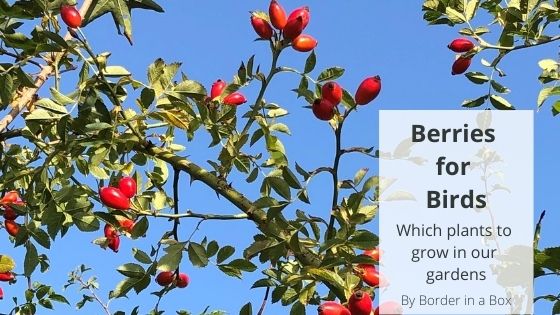
Not all birds will eat all berries – it depends on the size of the bird compared to how big the berry is. Which makes sense, so how can we feed as many birds as possible? Obviously, we need to grow a wide variety of flowers, trees and shrubs to support and care for our feathered friends who are vital to our garden eco-system. Here’s a few ideas…
Euonymus europaeus, commonly known as a Spindle tree, is stunning in the Autumn when the leaves turn bright red. Ideally plant it in a sunny spot, as it will look amazing in the sunshine. It has gorgeous, orange-pink, winged fruit which remain long after the leaves have fallen. Which makes it perfect for the birds too. This variety grows to around 3m tall and 2.5m wide.
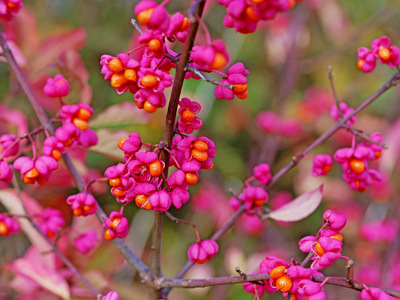
Cotoneaster ‘Hybridus Pendulus’ is another red berried shrub that grows to around 2m tall and 2m wide. We have one in our garden and the birds demolish the berries very quickly.
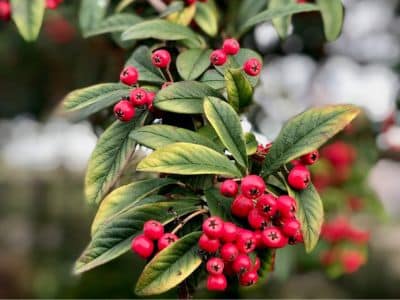
The most obvious tree to grow is the crab apple – there are many varieties available such as
Malus ‘Evereste’.
This is a tree that has year-round appeal as the white blossom in spring is beautiful and are loved by bees and other pollinators. It’s followed by bright fruits loved by blackbirds, thrushes and crows. Mammals, such as mice, voles, foxes and badgers, also eat crab apple fruit. The trees are best grown in full sun, but will tolerate some shade. Prefers fertile well drained soil. This particular variety is pollution tolerant and is an ideal ornamental tree for a small, urban garden. If any apples are left you can make crab apple jelly which goes well with meat.

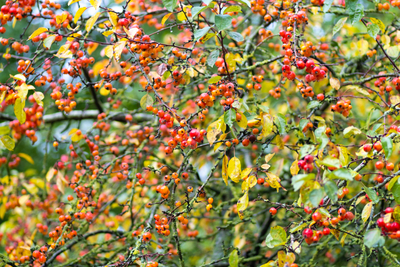
One of my favourite shrubs to grow is the
Callicarpa bodinieri var. giraldii ‘profusion’
which has beautiful purple berries in the autumn. It can grow in any well-drained soil in full sun or dappled shade. Grows to around 3m tall and 2.5m wide. I include it with the Clay version of Border in a Box – click here for more information Clay Border in a Box

If your plot doesn’t allow for trees, maybe a climbing honeysuckle and Ivy would be better. They can trail over gazebos and posts or grow against a sunny wall.
Lonicera fragrantissima
is a delightful winter-flowering shrub with fragrant, creamy-white flowers on almost leafless branches from November to February. These are followed by dull-red berries. The flowers are a magnet for winter-active bumblebees. Best to plant this variety in moist but well drained soil in full sun – especially by a path or doorway, so you can appreciate the fragrance from the flowers as you walk past.
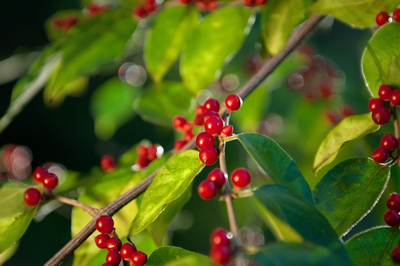
Sunflowers
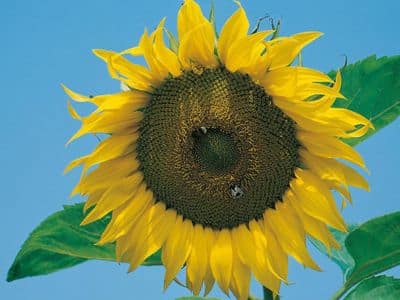
Sunflowers are so bright and cheery, and although they’re not berries, they’re a useful food source for insects when they’re in flower and when the seeds are mature, the finches love them too. It’s a win-win. There are new varieties available which are shorter, such as the Valentine (available from my online shop) which are a pale lemon colour.
You can also use the seeds to fill your bird feeders, or use them to make fat-balls. Here’s a recipe to make your own fat balls:
Ingredients:
250g Lard or suet
500g Mixed bird seed and rehydrated fruits
Method:
- Melt the lard in a saucepan over a low heat.
- Place the bird seed into a mixing bowl
- Add the melted lard to the mixing bowl and stir together, coating all of the seed
- Once cool to handle, use scoops of mixture and roll into a ball shape and place on a tray
- Place into the fridge overnight to solidify the balls
- Place into a bird feeder
Please note:
Avoid using turkey fat, which doesn’t set like suet and lard, and can coat birds’ feathers, preventing them from being able to fly. It can also spread disease. You should also refrain from using raisins and sultanas if you have a dog, as they are poisonous to them. Bear in mind that mealworms are harmful to hedgehogs, so only add these if you’re hanging fat balls in winter, when hedgehogs are hibernating.
 Free Delivery
Free Delivery Upgrade to 24 Hour Tracked Delivery
Upgrade to 24 Hour Tracked Delivery

